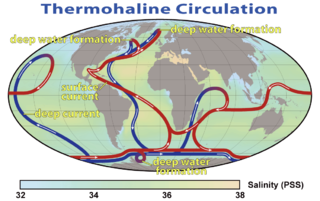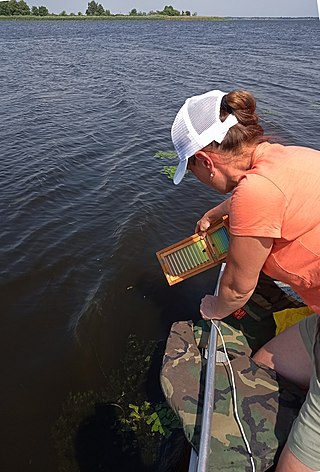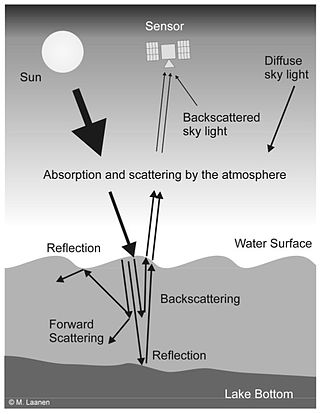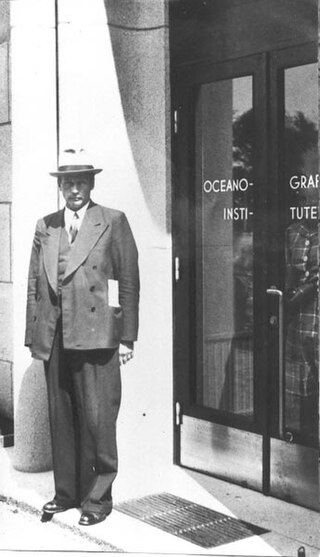In physics, attenuation is the gradual loss of flux intensity through a medium. For instance, dark glasses attenuate sunlight, lead attenuates X-rays, and water and air attenuate both light and sound at variable attenuation rates.

Oceanography, also known as oceanology, sea science, ocean science, and marine science, is the scientific study of the ocean, including its physics, chemistry, biology, and geology.

The Drake Passage is the body of water between South America's Cape Horn, Chile, Argentina, and the South Shetland Islands of Antarctica. It connects the southwestern part of the Atlantic Ocean with the southeastern part of the Pacific Ocean and extends into the Southern Ocean. The passage is named after the 16th-century English explorer and privateer Sir Francis Drake.

A research vessel is a ship or boat designed, modified, or equipped to carry out research at sea. Research vessels carry out a number of roles. Some of these roles can be combined into a single vessel but others require a dedicated vessel. Due to the demanding nature of the work, research vessels may be constructed around an icebreaker hull, allowing them to operate in polar waters.
Arne Isacsson was one of Sweden's most famous watercolour artists and art educators. He was also an author and professor and founded the Gerlesborg School of Fine Art in 1944. Isacsson's well-represented oeuvre explored, among other things, the properties of colour pigments in copious amounts of water.

Ocean color is the branch of ocean optics that specifically studies the color of the water and information that can be gained from looking at variations in color. The color of the ocean, while mainly blue, actually varies from blue to green or even yellow, brown or red in some cases. This field of study developed alongside water remote sensing, so it is focused mainly on how color is measured by instruments.

The Forel-Ule scale is a method to estimate the color of bodies of water. The scale provides a visual estimate of the color of a body of water, and it is used in limnology and oceanography with the aim of measuring the water's transparency and classifying its biological activity, dissolved substances, and suspended sediments.
Seibert Quimby Duntley was an American physicist. He was born in Bushnell, Illinois, on October 2, 1911.

The Albatross expedition (Albatrossexpeditionen) was a Swedish oceanographic expedition that between July 4, 1947, and October 3, 1948, sailed around the world during 15 months covering 45 000 nautical miles. The expedition is considered the second largest Swedish research expedition after the Vega expedition. The expedition was very successful, received international attention, and is considered one of the important steps in the history of oceanography.
The Hawaii Ocean Time-series (HOT) program is a long-term oceanographic study based at the University of Hawaii at Manoa. In 2015, the American Society for Microbiology designated the HOT Program's field site Station ALOHA a "Milestone in Microbiology", for playing "a key role in defining the discipline of microbial oceanography and educating the public about the vital role of marine microbes in global ecosystems."
The Oceanography Society (TOS) is a nonprofit society founded in 1988, based in Rockville, Maryland, U.S. and incorporated in the District of Columbia. It is an oceanographical organization that aims to promote communication among oceanographers, spread knowledge through research and education, and to provide a constituency for building consensus amongst the sub-disciplines of the field. The society publishes the scientific journal Oceanography, which publishes articles on all oceanic disciplines.

Water Remote Sensing is the observation of water bodies such as lakes, oceans, and rivers from a distance in order to describe their color, state of ecosystem health, and productivity. Water remote sensing studies the color of water through the observation of the spectrum of water leaving radiance. From the spectrum of color coming from the water, the concentration of optically active components of the upper layer of the water body can be estimated via specific algorithms. Water quality monitoring by remote sensing and close-range instruments has obtained considerable attention since the founding of EU Water Framework Directive.

Prof Hans Pettersson FRSFor HFRSE RSAS (1888–1966) was a 20th century Swedish physicist and oceanographer.

Bornö Marine Research Station, owned by the Bornö Institute for Ocean and Climate Studies, is located at Holma on the island Stora Bornö in Gullmarsfjorden, about 100 km (62 mi) north of Gothenburg, Sweden. It was built in 1902 by Otto Pettersson and Gustaf Ekman, both pioneers of Swedish marine research. The island has been considered by many Swedes to be the birthplace of Swedish oceanography.

Anna Wåhlin is a Swedish researcher on the Antarctic and the polar seas. She is a professor of physical oceanography at the University of Gothenburg and co-chair of the Southern Ocean Observing System.
Susana Agustí Requena is a Spanish biological oceanographer who has participated in over 25 oceanographic expeditions in the Arctic, Southern Ocean (Antarctic), Atlantic, Pacific and Indian Oceans. She played a key role in the Malaspina Circumnavigation Expedition. She is professor in Marine Science at King Abdullah University of Science and Technology in Saudi Arabia and an adjunct Professor at the University of Tromsø (Norway).

Ocean optics is the study of how light interacts with water and the materials in water. Although research often focuses on the sea, the field broadly includes rivers, lakes, inland waters, coastal waters, and large ocean basins. How light acts in water is critical to how ecosystems function underwater. Knowledge of ocean optics is needed in aquatic remote sensing research in order to understand what information can be extracted from the color of the water as it appears from satellite sensors in space. The color of the water as seen by satellites is known as ocean color. While ocean color is a key theme of ocean optics, optics is a broader term that also includes the development of underwater sensors using optical methods to study much more than just color, including ocean chemistry, particle size, imaging of microscopic plants and animals, and more.

The SeaWiFS Bio-optical Archive and Storage System (SeaBASS) is a data archive of in situ oceanographic data used to support satellite remote sensing research of ocean color. SeaBASS is used for developing algorithms for satellite-derived variables and for validating or “ground-truthing” satellite-derived data products. The acronym begins with “S” for SeaWiFS, because the data repository began in the 1990s around the time of the launch of the SeaWiFS satellite sensor, and the same data archive has been used ever since. Oceanography projects funded by the NASA Earth Science program are required to upload data collected on research campaigns to the SeaBASS data repository to increase the volume of open-access data available to the public. As of 2021 the data archive contained information from thousands of field campaigns uploaded by over 100 principal investigators.

Water clarity is a descriptive term for how deeply visible light penetrates through water. In addition to light penetration, the term water clarity is also often used to describe underwater visibility. Water clarity is one way that humans measure water quality, along with oxygen concentration and the presence or absence of pollutants and algal blooms.
John F. Marra is a biological oceanographer, academic, and author. He has been a member of the CUNY Doctoral Faculty in Earth and Environmental Sciences as well as the Doctoral Faculty in Biology since 2007.















